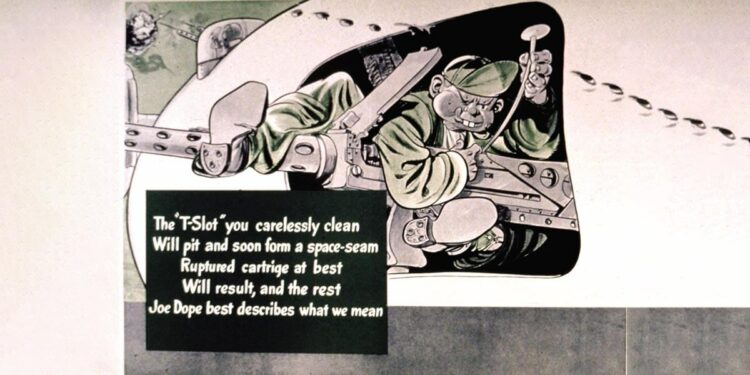By Robert Bruce
Why is Small Arms Review featuring cartoons? Well, while doing military weapons photo research in the National Archives, Robert Bruce stumbled across a series of decidedly comical posters with very serious messages for American GIs in WWII.
They were the work of Will Eisner, a talented young soldier/artist in the Army Ordnance Corps, whose goofy, buck-toothed main character Joe Dope showed how stupidity in too many common situations could prove fatal for himself and his fellow fighters. Will and Joe were so effective in this critical mission that the duo continued amusing and educating soldiers for nearly 30 years. A sobering reminder that Joe’s inexperienced descendants continued to find their way into the Army.
Eisner’s audience was the “Soldiers who have busted knuckles, greasy oily grimy hands, worn coveralls and scuffed boots … the Soldiers who keep the Army’s equipment ready. Rarely has art and the written word been so well blended. Will Eisner showed that content and sequential art complement one another.”
—Jonathan Pierce, the current editor (2019) of PS Magazine.
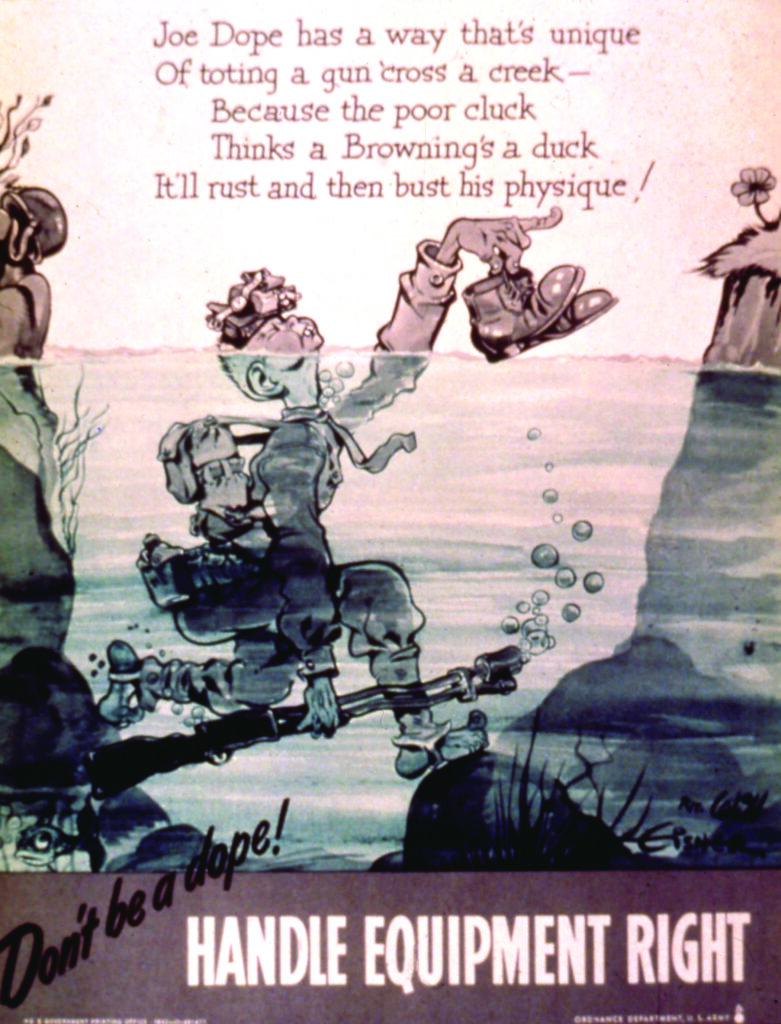
Joe Dope drowns his weapon. This dumb GI really gets around, not only in aircraft, but also as an infantryman. Here, he has chosen to keep his boots dry but doesn’t mind dunking his BAR. This convenience of the moment is likely to have fatal consequences in the next firefight if he doesn’t dry, clean and lube the weapon.
Soon after the Japanese sneak attack on Pearl Harbor in December 1941, William Erwin Eisner, a 24-year-old artist in the Brooklyn borough of New York City, got his draft notice from Uncle Sam’s U.S. Army. In an initially perplexing but ultimately perfect example of its rare propensity for properly fitting a man’s civilian skills to his military assignment, the Army sent him to the Ordnance Corps, responsible for guns, vehicles and other machinery of war.
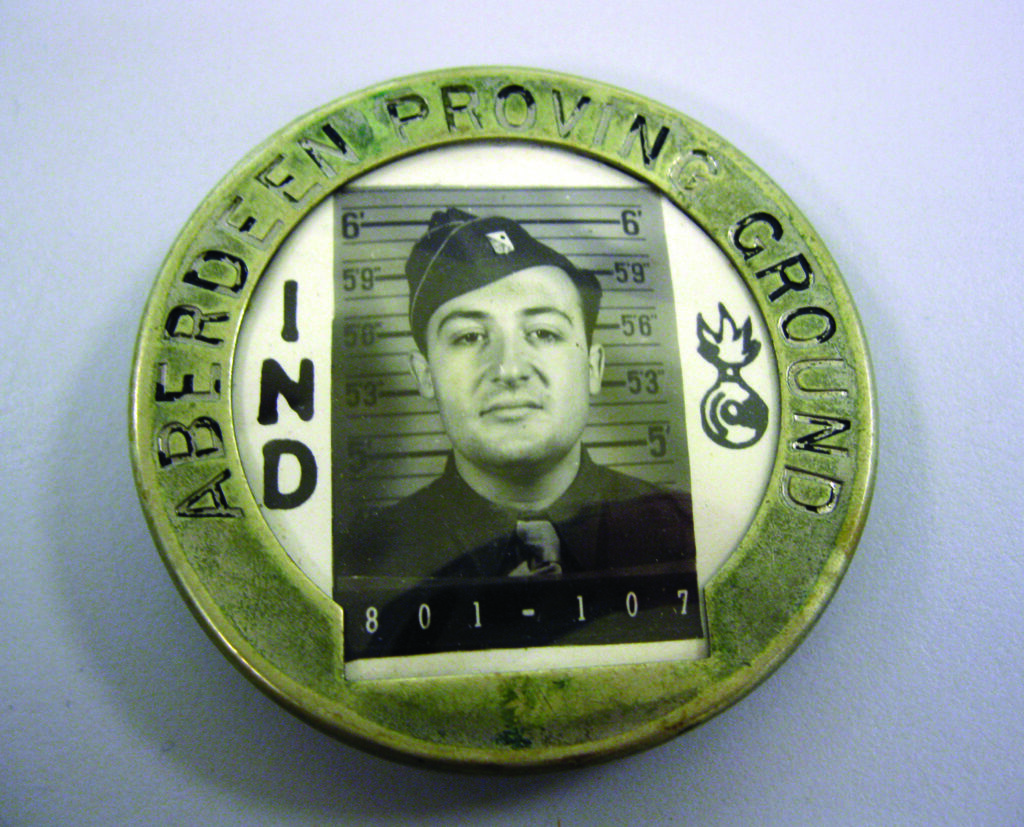
You’re in the Army now! Reporting for duty at the home of the Ordnance Corps in Maryland, 25-year-old Private Eisner is seen here with his “overseas cap” at a jaunty angle in his official ID badge photo.
There, Private Eisner’s civilian reputation as the creator of The Spirit, a highly successful comic book supplement in major newspapers in 1940, landed him a position as an illustrator for what was at the time a rather bland and technical maintenance newsletter named Army Motors. Equally remarkable, Will was able to persuade the senior officer who was in charge—not to mention enough of the other old-school brass—that his well-proven comic book style would be a much better way to grab and hold the attention of the Army’s tidal wave of brand new draftees and enlistees.
The Dopiest Draftee
It wasn’t long before Eisner headed up the publication’s art department, showcasing his unique drawing style and storytelling. Soon, catching the attention of higher ups, he spent the rest of the war years plying his cartoonish training trade while on the staff of the Chief of Ordnance at the Pentagon. Interestingly, he leaped from Private to Warrant Officer by way of indispensable talent and skirting the arduous Warrant Officer Candidate School ordeal with “a written test.”
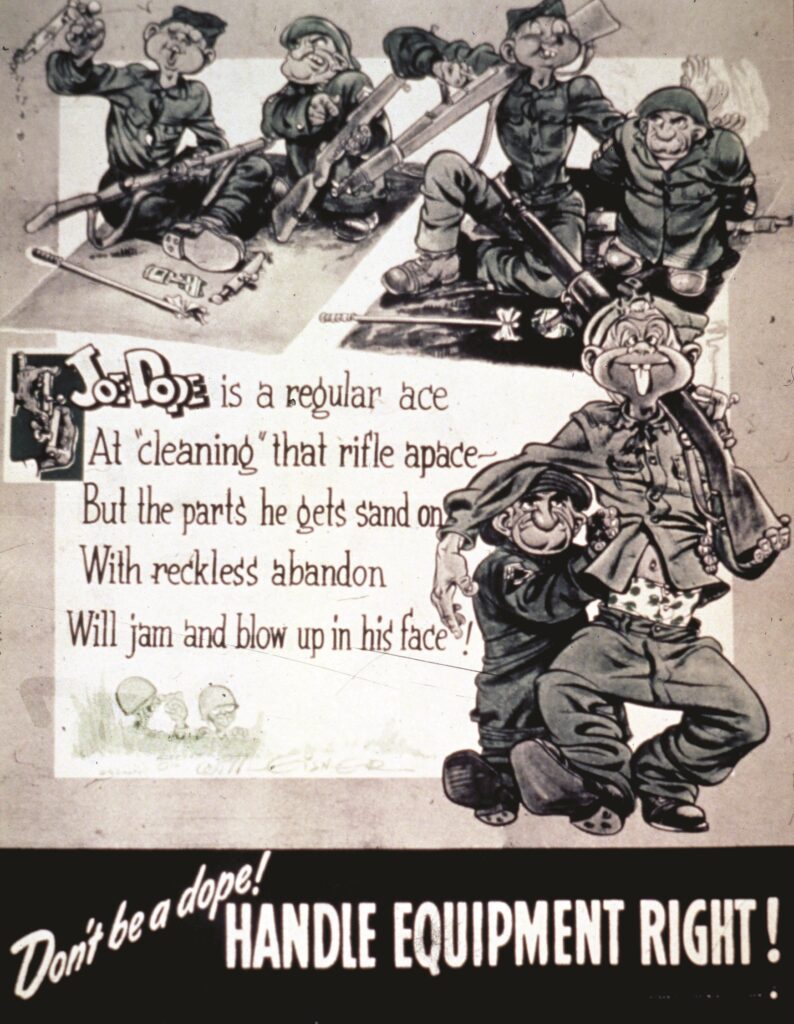
“Cleaning” caution. Very likely among Eisner’s earliest cartoon Ordnance posters, he uses multiple images to tell this sad tale. Joe Dope lets the bolt and other parts from his M1903 rifle sit in the dirt while he thinks he’s cleaning it. When the crusty old veteran sergeant fails to convince him of the error, we see a dazed Joe suffering from inevitable catastrophic failure.
Along the way and in the company of stern, square-jawed Master Sgt Half-Mast McCanick and the pneumatically pulchritudinous Connie Rodd, Eisner’s doofus, dogface Joe Dope became the main character in posters and in Army Motors, illustrating what NOT to do in a wide variety of situations on land and in the air.
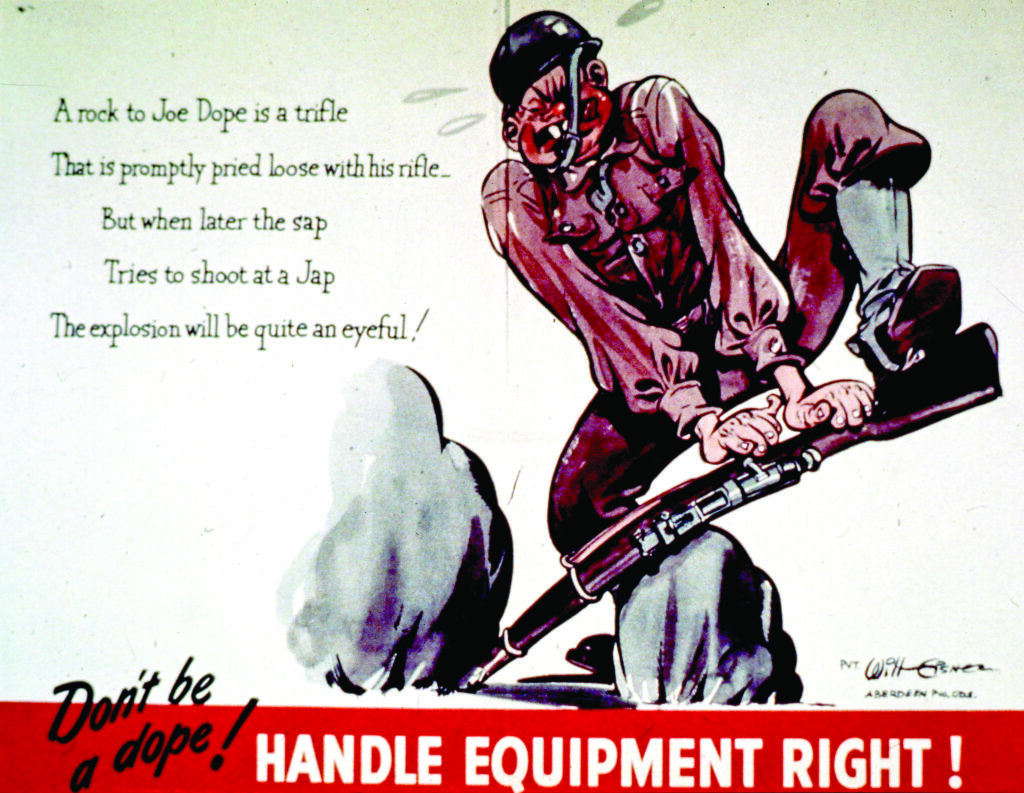
M1903 pry bar. Seeing Pvt Will Eisner’s distinctive signature at bottom right of the poster, it’s another of his early works, showing Joe Dope abusing his .30 caliber, bolt-action M1903; probably to get a rock out of the way of where he’s going to dig a foxhole. Bending barrels in any manner not only ruins accuracy, but in extreme situations can literally blow up the action.
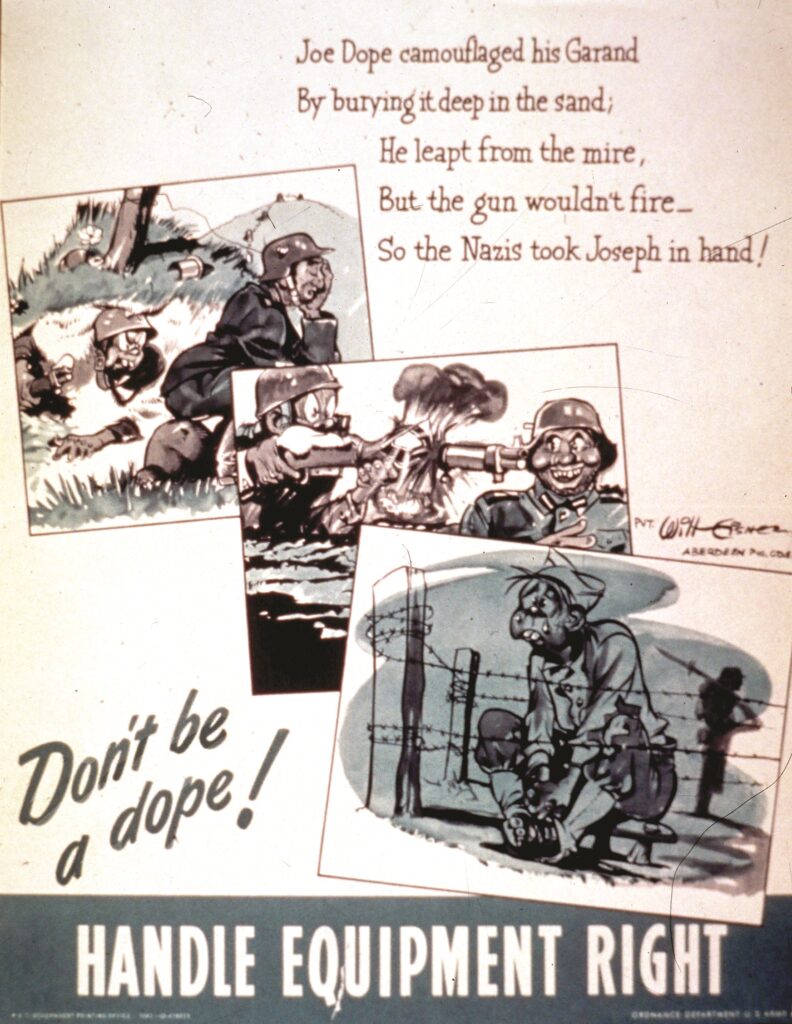
Gritty Garand. As more M1 Garands entered service, this superlative .30 caliber semiauto became the Army’s standard infantry rifle, starring here as yet another victim of Joe Dope’s serial stupidity. Eisner was still a Private, so this is another early work. The limericks, by the way, were usually written by Eisner, but others were sent in by GI poets from all over the fighting fronts.
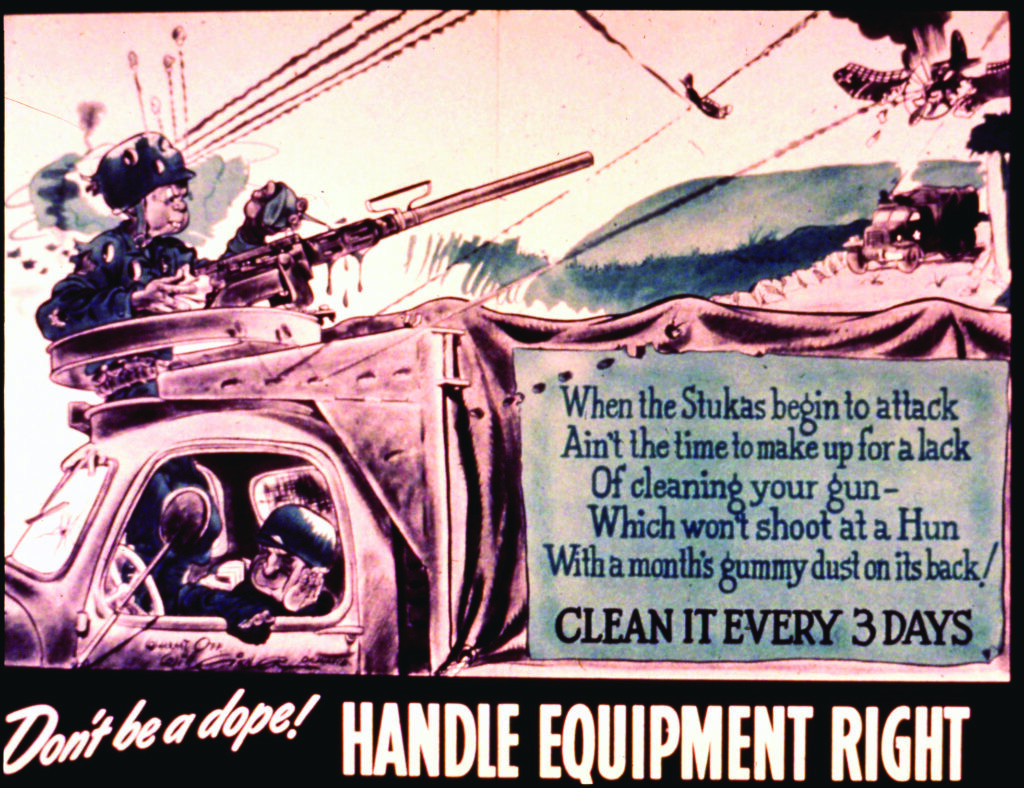
Gummed up gun. Joe Dope, as a .50 M2 BMG gunner in the AA ring mount of a cargo truck in convoy, hasn’t bothered to regularly clean his “Ma Deuce.” Oil atop the grit won’t help get it into action when a German dive bomber starts putting big cartoon holes in Joe. Seen in the truck’s cab, his long-suffering top sergeant seems uncharacteristically resigned to inevitable death. By this time in the War, Eisner is a Warrant Officer Candidate as barely seen in his signature on the truck’s door.
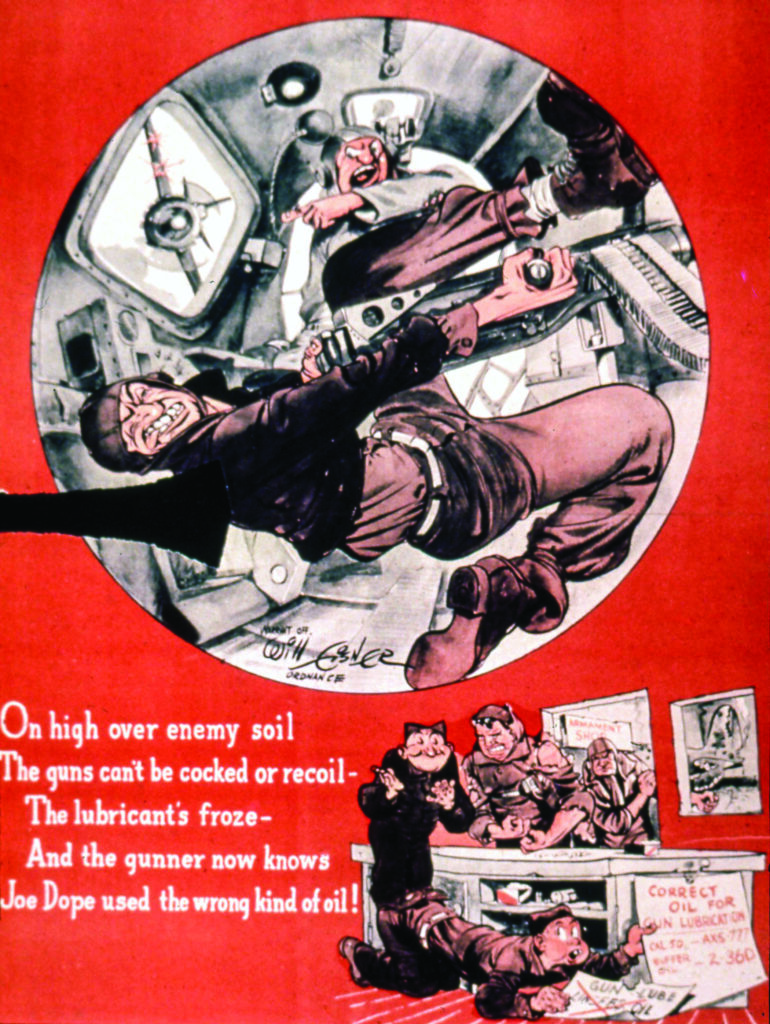
High over enemy soil. Even the beautiful Browning won’t work when its lube oil freezes, leading to this aerial combat catastrophe. Barely making it back to base in their shot-up bomber, the irate crewmen storm into the Armaments Shop while Joe Dope the culprit cowers on the floor. A reminder of the correct lubricants to use is seen at the bottom right. Notice Eisner’s signature as Warrant Officer.
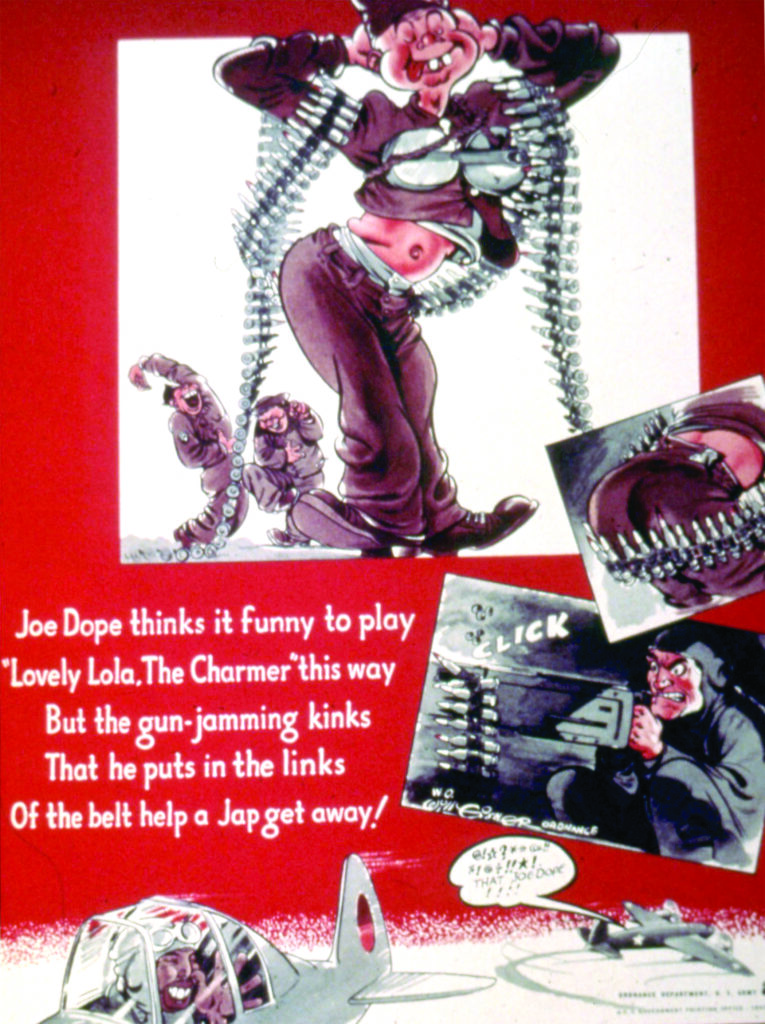
Lovely Lola. Joe, dancing provocatively with mess kit brassiere and ammo belt boa. While it’s not absurd to think that some GIs clowned around this way, the real issue in most situations was careless handling of the big Browning’s heavy, steel-linked ammo belts. Knocking rounds out of alignment and twisting the links almost guarantees a stoppage and at the worst possible time.
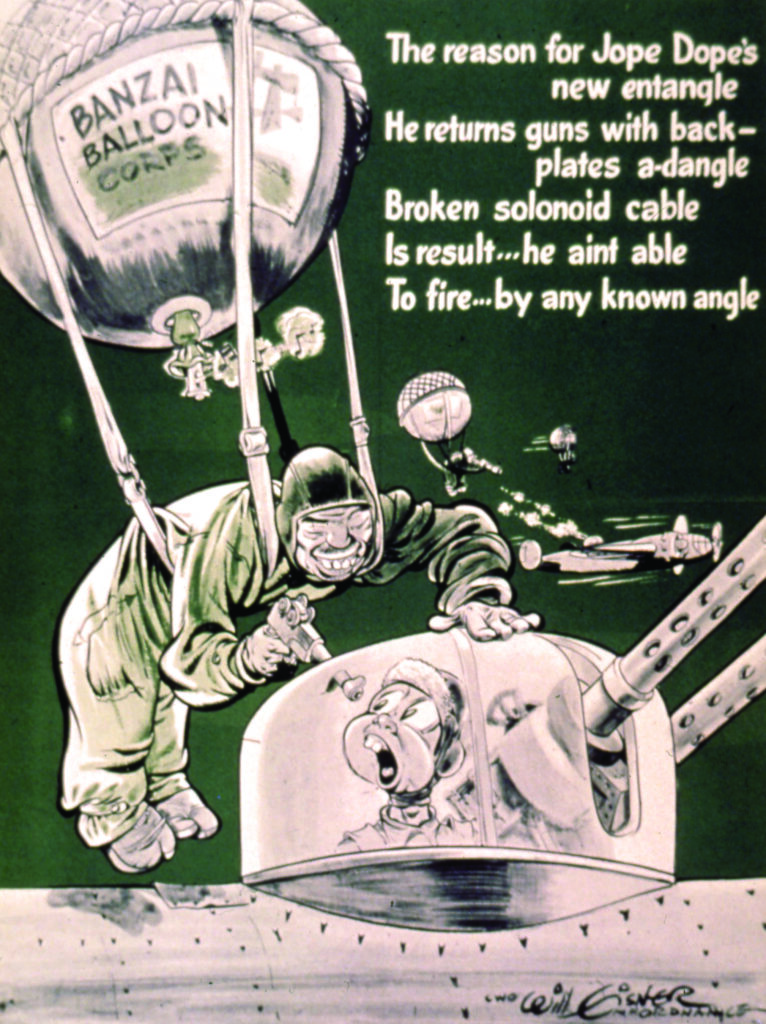
Banzai Balloon Corps. Twin .50s in aircraft turrets and other multiple mountings were fired by electrical solenoids built into the backplate that links by power cable to a central trigger box. When dismounting the guns for cleaning, it’s important to leave the backplate on the gun to protect the fragile electrical cable and connectors. Although Eisner’s caricature of the Japanese balloonist was pretty much standard back then, “political correctness” dropped like an anvil on him in later years.
Mangling Ma Deuce
It was in the particularly unforgiving arena of aerial combat that Joe did most of his damage while assigned to bomber squadrons. Apparently incapable of following maintenance requirements as an armorer, or putting his intense training in air-to-air gunnery to good use, Joe repeatedly imperiled the lives of his fellow airmen.
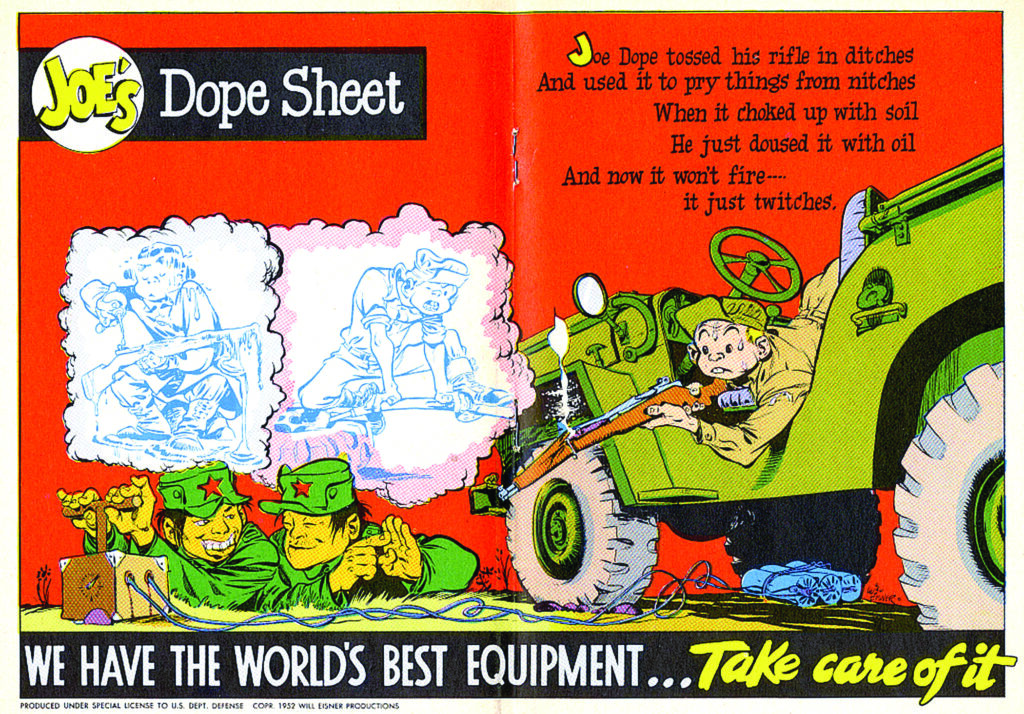
Korean War Joe’s M1. The superlative M1 Garand of WWII soldiered on in the Korean War as the Army’s primary rifle; fast-firing, accurate and reliable if given at least basic care and maintenance. Unfortunately, a new crop of Joe Dopes makes the same stupid mistakes as their predecessors. In No. 8, 1952, Joe’s Dope Sheet, always the two-page center spread in PS Magazine, shows Chinese Communist soldiers ready to blow up Joe and his Jeep. In the lexicon of the times, “Dope Sheet” is the opposite of stupid, providing good info when needed. Eisner and his company had a unique business deal with the Ordnance Corps as noted at bottom left.
Interrupting a 5-Year Leave
With unconditional surrender of Nazi Germany and Imperial Japan in 1945, Eisner was mustered out and resumed his artistic and entrepreneurial work in New York City at the top tier of the comics world. He launched American Visuals Company (AVC) in 1948 with a roster of talented artists and prestigious clients like General Motors and U.S. Steel. Then, as fate would have it, AVC was perfectly positioned when war in Korea broke out in 1950.
American soldiers were back in the thick of battle, this time fighting hordes of Communist invaders in a strange land far from home. The pressures of war and another flood of young, inexperienced Joe-Dope-type draftees now manning old and poorly maintained vehicles, weapons and equipment left over from WWII spurred the Ordnance Corps to revive Eisner’s unique cartoon method for quick, effective, basic maintenance instruction.
The “Postscript” Pamphlets
It was perhaps a combination of patriotism and persuasion backed by enough money that brought civilian Eisner back into government service to the job he clearly loved of educating GIs. PS Magazine, The Preventive Maintenance Monthly, his pamphlet-sized, semi-comic magazine, sprang to life from the drawing boards of AVC’s bullpen of artists in June 1951.
PS is short for postscript, indicating that it was intended to be a useful addition and supplement to sagging shelves full of necessarily fat, fact-filled Field and Technical Manuals. In addition to short instructional features on specific subjects, it answered questions and handily included brief maintenance tips and clever “field expedients” from the “busted knuckles … scuffed boots” crowd out there in the real world.
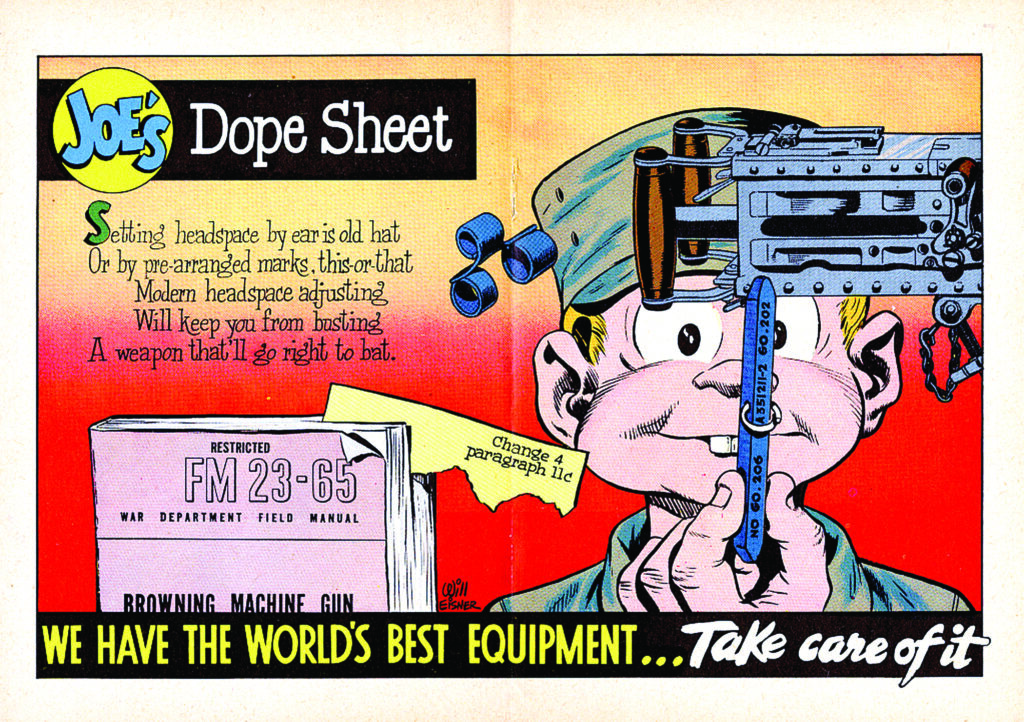
Headspace gauge. The .50 caliber Browning M2 Machine Gun continues even today as an astonishingly reliable and hard-hitting warrior’s workhorse when properly maintained. But its headspace and timing adjustments require diligent, knowledgeable attention. Because too many guns fail to fire or even blow up when imprecise “field expedient” methods are used, in PS Magazine, No. 28, 1955, Joe’s Dope Sheet exhorts his fellow soldiers to use this precision headspace gauge instead of “this-or-that” steel link loops. The yellow tab sticking out of “FM 23-65” points gunners to the latest change information on the combo headspace and timing gauge.
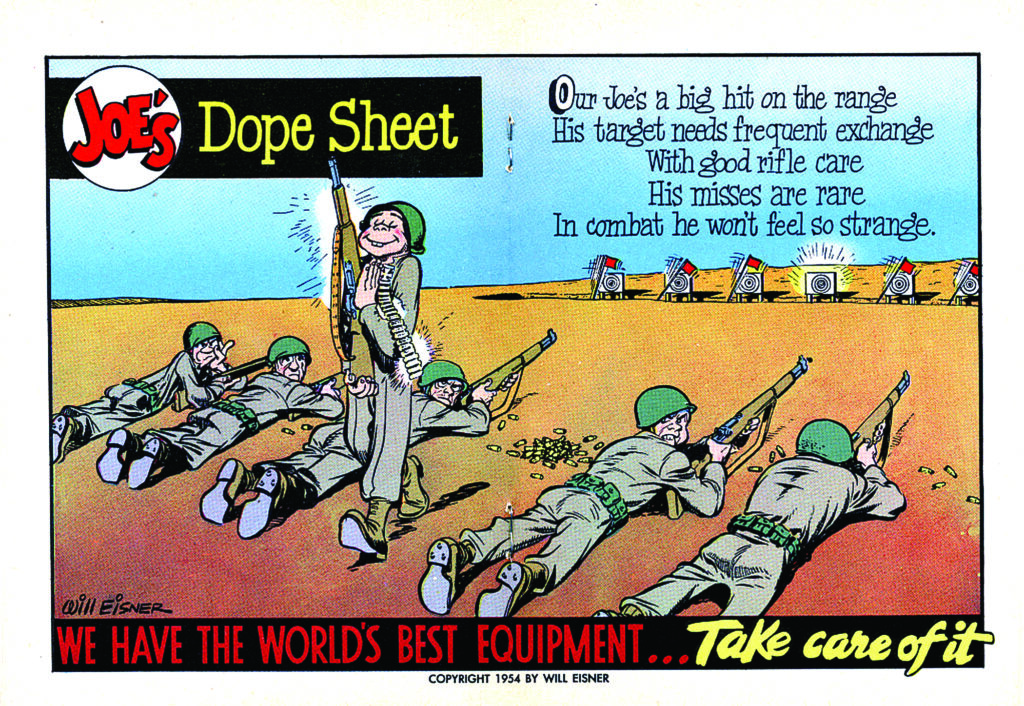
Big hit on the range. By 1954, apparently even Joe is beginning to get smart, thanks to information found in PS Magazine, No. 26. While his buddies are getting “Maggie’s Drawers” (red flag for misses) M1-maintaining, Expert badge, Joe put ’em all in the black.
PS Goes PC
PS Magazine came out sporadically over the first 2 years until after most shooting stopped with the Armistice Agreement in July 1953. Then, with the pressures of war somewhat relieved, Eisner began to be put upon by Pentagon Social Justice Warriors to give Joe Dope a cosmetic and conduct makeover. The evolution began gradually but then it sped up.
The brass hats ridiculously ruled that Joe the jerk reflected badly on an idealized “American Fighting Man.” Eisner saved face—literally—in PS Magazine, No. 47, 1956, recounting how Joe blew himself up after bungling headspace adjustment on an M2. Army doctors rebuilt his ugly mug, dentists fixed his buck teeth and from then on he was always properly groomed and uniformed.
Over time, Eisner’s mean old Half-Mast mellowed and most sadly, poor Connie’s appearance, wardrobe and her soldier-stimulating situations gradually became less and less sexy. The emphasis in PS Magazine shifted to more and more detailed info with fewer examples of the wonderfully outlandish cartoon characters drawn by the master himself and his talented minions who specialized in the technical-type illustrations.
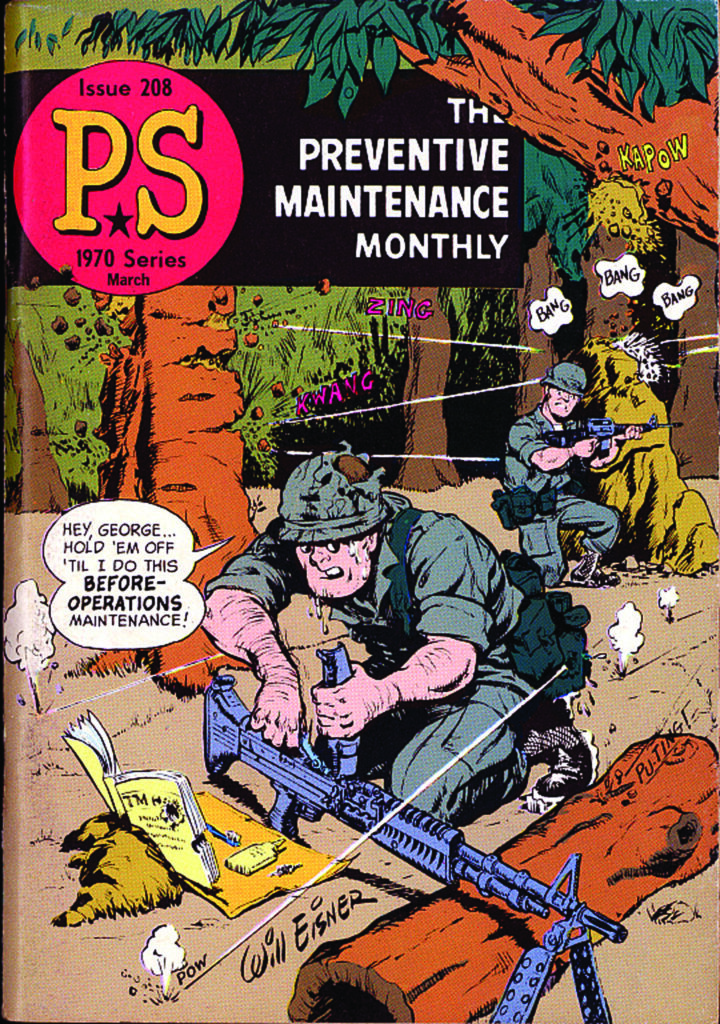
M60 ‘Nam. This March 1970 issue of PS Magazine brings us into the thick of infantry combat in the Vietnam War, and wouldn’t you know it, there’s yet another GI machine gunner having serious problems. Goofy Joe is long gone by now, replaced here by a beefy grunt who apparently didn’t bother to do the “before operations maintenance” specified in the Technical Manual for his 7.62mm M60 “Pig.” In true comic book style, enemy bullets “zing,” “kwang” and “pow” all around, even hitting the guy’s helmet, canteen and putting extra holes in the manual. Note the essential toothbrush and a squeeze bottle of LSA.
Vietnam and After
Eisner had an undeniable sense of duty, as demonstrated in some weeks-long, info-gathering visits to soldiers in the fields including battle zones in Korea as well as Cold War Germany and Japan. Around the time of the Tet Offensive (January 1968) he again made the rounds in Vietnam, gaining insights evident in contemporary issues of PS Magazine and—most notably—the iconic M16A1 Rifle: Operation and Preventive Maintenance comic book.
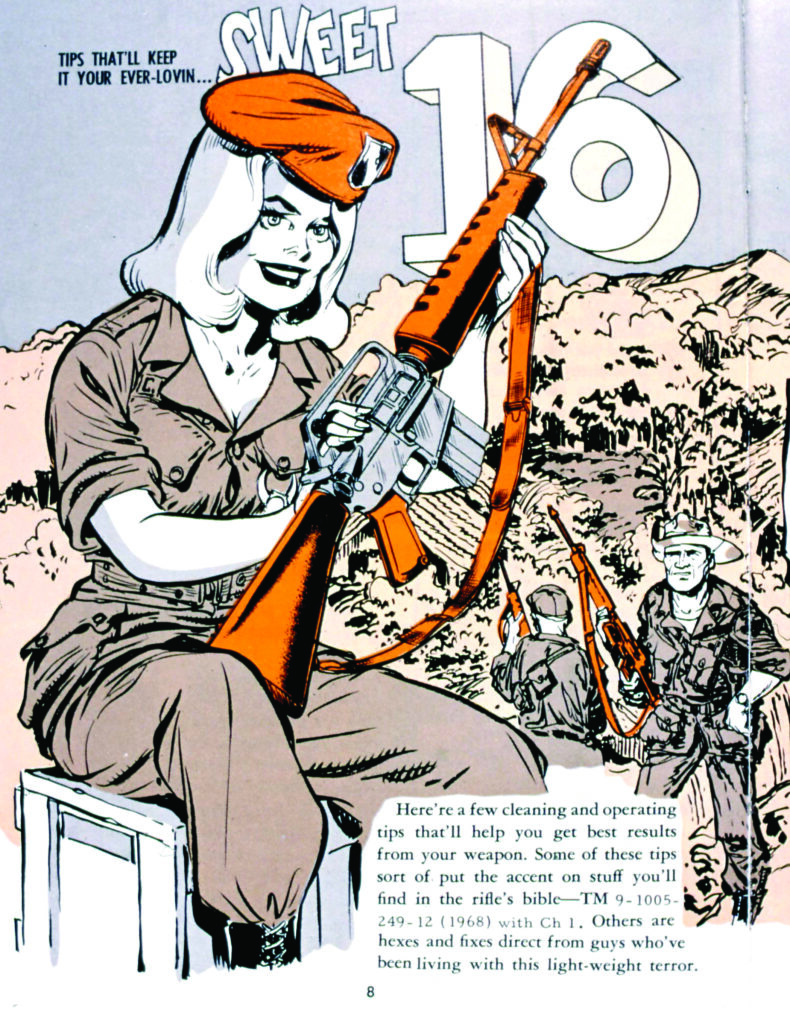
Sweet 16. Inside this 30-page pamphlet we find Connie Rodd with her very own “Sweet 16,” now apparently serving as an special adviser with the “Green Berets.” In images apparently sneaked past Pentagon prudes, the forever young Connie is drawn in classic Eisner style with trademark blond tresses, lipstick smile and a bit of cleavage straining the top button of her early version jungle fatigues. She also directs our attention to detailed instructions in the rifle’s official Technical Manual as well as “hexes and fixes direct from the guys who’ve been living with this light-weight terror.”
Eisner eventually tired of fighting the Pentagon’s PC being pushed on PS Magazine, so he gave up the publication contract in 1971, closing out his 227th consecutive issue. But the 54-year-old didn’t goldbrick, and he went on with renewed enthusiasm to write, illustrate and publish a slew of what are now known as “graphic novels.” Among these notables is the very personal A Contract with God and his bittersweet Last Day in Vietnam, with a timeline of real-life vignettes from the three wars he experienced first-hand.
The “New and Improved” PS Magazine
Today’s PS Magazine—steadily moving past issue 800 and now in digital form only—is a far cry from the rollicking, risqué days of Eisner and his team. As more and more women have poured in to the Army, the last traces of testosterone petered out. Perhaps this is understandable on some levels, but we old GIs know what Eisner-style fun the new generation is missing.
See for yourselves now that PS Magazine has gone online and accessible to anyone—friend and foe alike—logsa.army.mil/#/psmag.
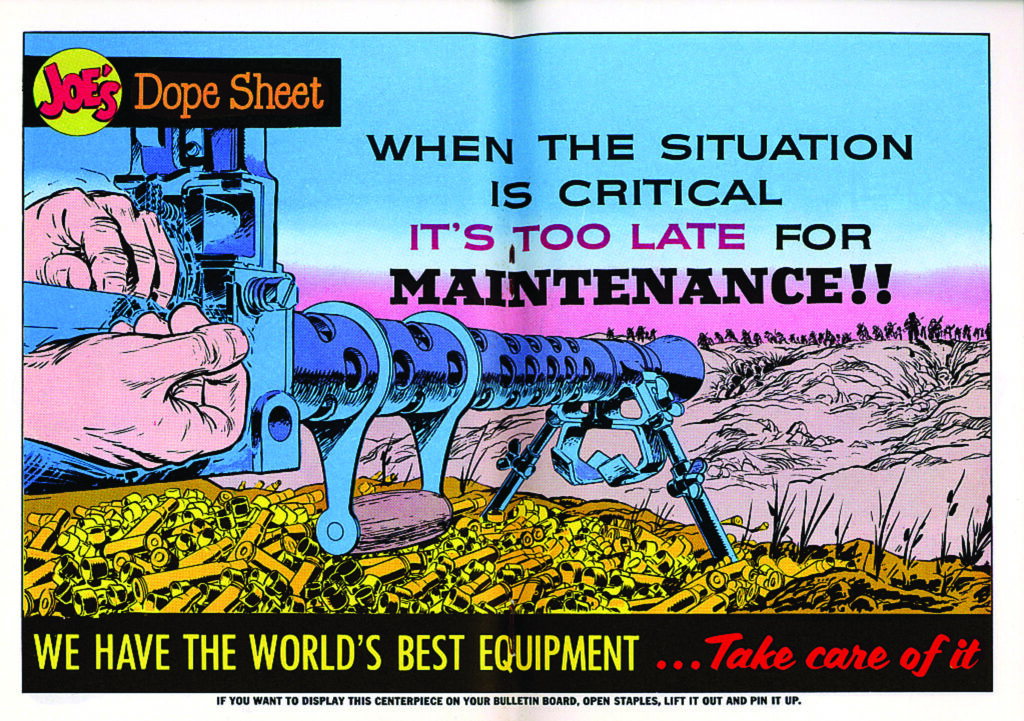
When the situation is critical. PS Magazine, No. 112, 1962, when the Cold War wasn’t so cold. Judging from that pile of links and expended brass, this .30 cal. Browning M1919A6 was working fine until something really bad happened. Now, the gunner is frantically trying to clear a jam while enemy infantry attacks. Note the bottom statement: “IF YOU WANT TO DISPLAY THIS CENTERPIECE ON YOUR BULLETIN BOARD, OPEN STAPLES, LIFT IT OUT AND PIN IT UP.” Not signed by Eisner, as he customarily does when approving a layout, its realistic style probably means it was drawn by another AVC artist.
FOR MORE INFORMATION
WHNT News 19 video: whnt.com/2016/04/01/defending-america-for-65-years-with-ps-magazine/
PS Magazine issues 1–229 at Virginia Commonwealth University: digital.library.vcu.edu/digital/collection/psm
PS Magazine issues 1951 to 2014 at Radionerds.com: psmag.radionerds.com/index.php/Main_Page
PS Magazine from 1999 to Present: logsa.army.mil/#/psmag
Downloadable M16A1 Rifle: Operation and Preventive Maintenance comic book: oberlandarms.com/pdf/m16a1_rifle_operation_and_preventive_maintenance_1969.pdf PS Magazine: The Best of the Preventive Maintenance Monthly, by Eddie Campbell, 2011
| This article first appeared in Small Arms Review V24N1 (Jan 2020) |



